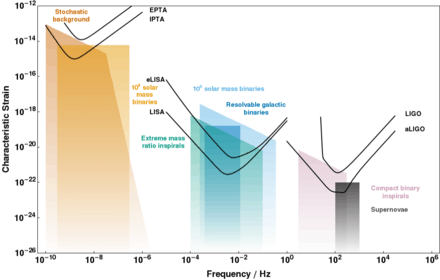Big Bang Observer
| Telescope style | gravitational-wave detector |
|---|---|
The Big Bang Observer (BBO) is a proposed successor to the Laser Interferometer Space Antenna (LISA). The primary scientific goal will be the observation of gravitational waves from the time shortly after the Big Bang, but it will also be able to detect younger sources of gravitational radiation, like binary inspirals. BBO will likely be sensitive to all LIGO and LISA sources, and others. Its extreme sensitivity comes from the higher-power lasers, and correlation of signals from several different interferometers located around the Sun.
The first phase resembles LISA, consisting of three spacecraft flown in a triangular pattern. The second phase adds three more triangles (twelve spacecraft total), spaced 120° apart in solar orbit, with one position having two overlapping triangles in a hexagram formation.
The individual satellites will differ from those in LISA by having far more powerful lasers. In addition each triangle will be much smaller than the triangles in LISA's pattern, about 50,000 km instead of 1 to 5 million km. Because of this smaller size, the test masses will experience smaller tidal deviations, and thus can be locked on a particular fringe of the interferometer — much as in LIGO. By contrast, LISA's test masses will fly in an essentially free orbit, with the spacecraft flying around them, and interferometer fringes will simply be counted, in a technique called "time-delay interferometry".
The BBO instruments present massive technological challenges. Funding has not been allocated for development, and even optimistic estimates place the instrument's launch date many decades away.
See also
- Cosmic gravitational wave background
- Gravitational wave
- Laser Interferometer Space Antenna
- LISA Pathfinder
Further reading
- Crowder, Jeff; Cronish, Neil J. (October 2005). "Beyond LISA: Exploring Future Gravitational Wave Missions". Physical Review D. 72 (8): 083005. arXiv:gr-qc/0506015
 . Bibcode:2005PhRvD..72h3005C. doi:10.1103/PhysRevD.72.083005.
. Bibcode:2005PhRvD..72h3005C. doi:10.1103/PhysRevD.72.083005. - Gravitational Wave Missions from LISA to Big Bang Observer, WM Folkner, JPL - 2005
- The Big Bang Observer, Gregory Harry (MIT), LIGO-G0900426

